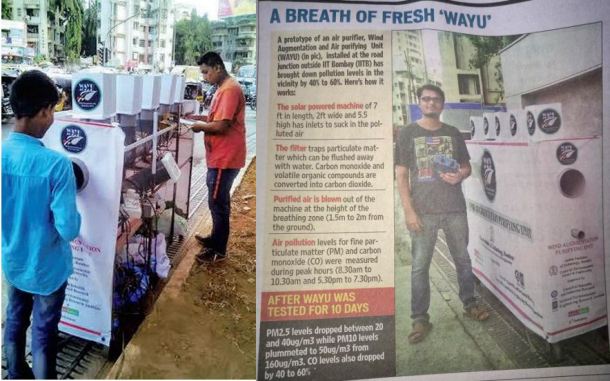Meet WAYU – India’s solar–powered device that cuts air pollutants by 40-60 %

While Indian government is a total failure in understanding and taking any considerable action to check the levels of rising air pollution, IIT- Bombay has invented an air purifier that can prove to be a an effective tool to fight air pollution at most crowded as well as polluted intersections in Bombay.
Air pollution is a grieve issue in India. WHO survey had declared India’s capital Delhi as world’s most polluted city. Delhi is two times more polluted than Beijing. Rests of the metropolitan cities are not far from high levels of pollutants in air. The survey had also revealed that India claims 10 of the world’s most polluted cities.

Unfortunately, another report confirms that 44 lakh children in Delhi are suffering from various respiratory and lung disorders in one way or other due to inhalation of high level of pollutants with air.
So, any development in preventive technologies holds a lot of value for India.
The newly invented device is named WAYU or Wind Augmentation and Air Purifying Unit that is developed in collaboration with IIT-Bomby, National Environmental Engineering Research Institute (NEERI) and Maharashtra Pollution Control Board.
The prototype device was tested last month and was found to be an excellent tool to reduce amount of air pollutants at crowded intersection upto a 30-meters radius.
The device work on two basic principal ; breaking down carbon monoxide and Volatile Organic Carbon (VOC) into carbon dixoxide and wind generation for dilution or air pollutants with active removal of pollutants.
According to Vinayak Padalkar, an M-Tech Student at IIT-Bombay who is involved in the development of the project said:
“In WAYU, the air passes through a thermal oxidiser, which heats up the air, breaking the carbon monoxide and VOCs into carbon dioxide. We can run this device on solar energy and the next set of tests will be done using only solar power.”
The device can also be powered by solar panels and after it gets green light from government, we might see hundreds of such units placed at various intersection in the city, powered completely by solar energy.
With successful testing and satisfactory results, government is planning to approve it for use at 100 different locations. Perhaps, the inventors might think about building larger units with more range and higher capacity.
The inventors designed it specifically for intersections because the emission rate is higher at these points. According to Dr Rakesh Kumar, chief scientist and head of NEERI:
“The problem of air pollution multiplies at vehicular intersections as a vehicle typically accelerates, remains idle and decelerates when it comes across intersection and this causes higher amounts of pollutants to be released in the atmosphere. These pollutants get trapped leading to higher exposure for people stuck in traffic, or living or working in buildings surrounding the intersections.”
WAYU was tested from May 24 to June 4 after it was placed at IIT junction. The results were stunning. It cut down the concentration of pollutants by 40-60 percent within a diameter of 30-meter.
Padalkar further added:
“Before developing the prototype, we had carried out air quality testing in the one-km area of IIT gate and found that a BEST bus stop would be perfect for testing, as it was the worst affected, with several people directly exposed to a high level of pollutants. Under the mentorship of Dr Rakesh Kumar and Prof Rashmi Patil, CESE, IIT-B, we started working on the prototype from February and managed to get it ready by May.”
WAYU can prove to be a simple, effective, and low-cost way to deal with pollutants in cities. The study points that device brought down the level of carbon monoxide to 3.5 -3.8 ppm from 7-8 ppm recorded during peak hours.
In terms of particulate matter, the level dropped down from 260-30 mg.m3 to 100-130 mg/m3 in a limited radius. The inventors are now looking to refine the device and give it sleeker and user-friendly design.
,